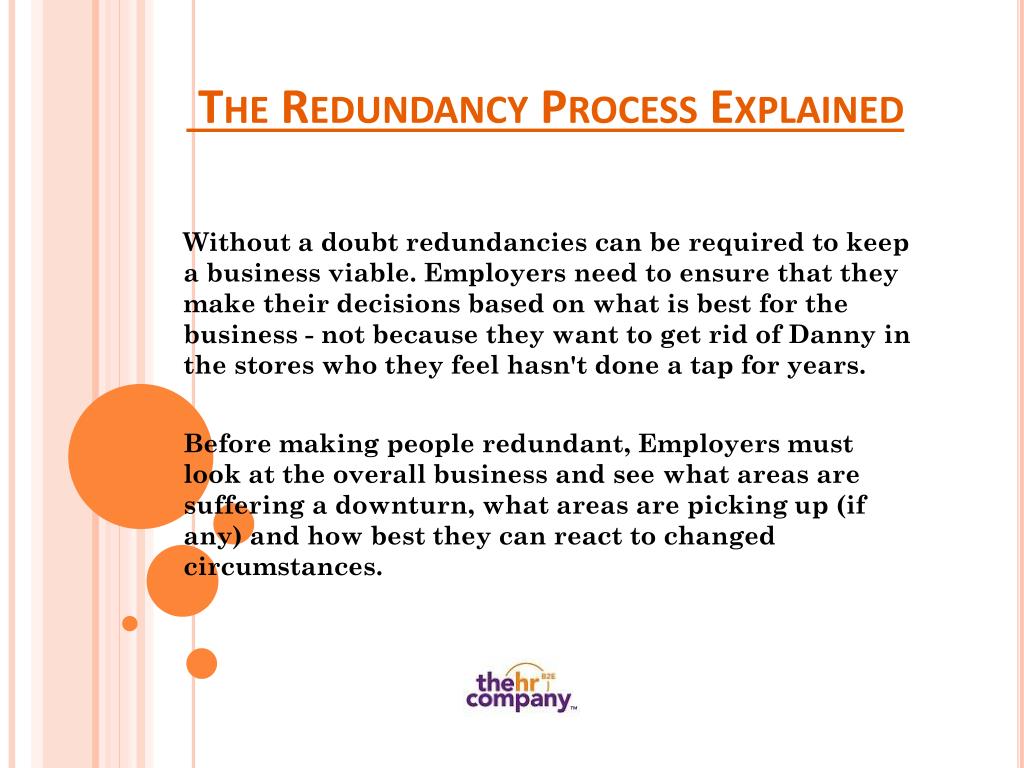Redundancy Pay If Company Goes Bust: Understanding Your Entitlements in the UK
Redundancy Pay If Company Goes Bust: Understanding Your Entitlements in the UK
Blog Article
Exploring the Interaction In Between Firm Redundancy and Organizational Versatility for Future Growth
In the dynamic landscape of today's service globe, the intricate partnership in between company redundancy and business flexibility arises as a vital variable for sustained development and success. Firms usually encounter the difficulty of striking a fragile balance in between preserving a level of redundancy to alleviate threats and promoting adaptability to react swiftly to the ever-evolving market needs.
Relevance of Company Redundancy
Business redundancy is an important aspect that enhances business resilience and alleviates operational risks. By including redundancy procedures within the business framework, firms can better endure unexpected interruptions and variations in the service environment. Redundancy functions as a tactical buffer, permitting firms to adapt and react successfully to unanticipated obstacles without endangering essential procedures.
One secret facet of the relevance of business redundancy is its function in making sure continuity during times of situation. When faced with sudden adjustments or emergency situations, redundant systems, resources, or employees can action in to preserve vital functions and avoid widespread disruptions. This continuity not just safeguards the firm's reputation and customer depend on yet additionally minimizes economic losses and functional downtime.

Approaches for Organizational Adaptability

An additional crucial method is purchasing technology and framework that can support versatility and scalability. Executing electronic tools, automation, and information analytics can improve operations, boost performance, and supply useful understandings for informed decision-making. Additionally, producing adaptable business frameworks that enable quick modifications to market characteristics and client demands is essential for remaining affordable in a swiftly advancing setting. By proactively determining prospective interruptions and chances, organizations can proactively adapt and thrive in an ever-changing service landscape.
Balancing Redundancy and Adaptability
Attaining an unified balance in between functional redundancy and business versatility is critical in navigating the intricacies of a vibrant company atmosphere. Redundancy within a business gives a safeguard, guaranteeing connection and security in operations. Nevertheless, an extra of redundancy can result in ineffectiveness and impede flexibility to transforming market problems. On the various other hand, business versatility allows firms to react without delay to exterior disturbances and take brand-new chances. Striking the right equilibrium between redundancy and adaptability is a fragile process that calls for a deep understanding of the company's objectives, sector characteristics, and danger tolerance.
To accomplish this equilibrium, firms need to carry out normal assessments of their operations to determine locations where redundancy is essential for threat reduction and where adaptability can drive development and development. Applying flexible frameworks, cultivating a society of continual understanding and improvement, and encouraging open communication across all levels of the organization are crucial strategies to balance redundancy and versatility properly. By straightening these 2 crucial aspects, business can position themselves for sustainable growth and success in an ever-changing company landscape.
Study on Adaptation Success
In analyzing instances of successful organizational adaptation, it becomes apparent that the interplay between operational redundancy and versatility is a specifying factor in shaping durable companies. One engaging study is that of Netflix. At first a DVD rental service, Netflix showed amazing adaptability by transitioning into a streaming system when digitalization disrupted the sector. By tactically buying innovation and content development, Netflix not just endured but prospered in a swiftly advancing market. One more standout example is Amazon. Starting as an on the internet book shop, Amazon constantly adjusted its service model, increasing into see page varied sectors such as cloud computing and fabricated intelligence. This versatility allowed Amazon to stay in advance of rivals and meet altering customer demands. Finally, Adobe provides a notable image of successful adjustment. The go to this web-site firm shifted from marketing software application licenses to a subscription-based model, making certain recurring earnings streams and improved customer engagement. These study underscore the value of functional redundancy combined with organizational adaptability in cultivating lasting development and competitiveness.
Structure Resilience for Future Growth
Structure resilience for future development calls for a strategic placement of functional processes with market dynamics and arising patterns. Firms should adjust to altering atmospheres by cultivating a culture of adaptability, advancement, and continuous renovation. Durability entails not just recovering from problems yet likewise proactively preparing for future obstacles. One key element of structure durability is buying durable risk administration strategies to reduce prospective disturbances. This includes circumstance planning, diversifying supply chains, and developing backup strategies for numerous contingencies (who pays redundancy money).
Moreover, fostering solid partnerships with stakeholders, such as consumers, employees, distributors, and the neighborhood, is necessary for weathering uncertainties and keeping trust and support throughout stormy times. Reliable interaction and transparency play a crucial duty in building durability, as they aid promote and align expectations partnership in browsing unpredictabilities.
Additionally, companies require to focus on knowing and advancement campaigns to upskill employees and equip them with the needed tools to adapt to transforming circumstances. By spending in their workforce, business can boost their versatility and dexterity, ultimately reinforcing their durability for lasting future development.
Verdict

In the dynamic landscape of today's company websites world, the complex partnership between firm redundancy and organizational adaptability arises as a critical aspect for sustained development and success. Companies often deal with the challenge of striking a delicate equilibrium between keeping a degree of redundancy to minimize dangers and fostering flexibility to respond promptly to the ever-evolving market demands.To accomplish this equilibrium, firms need to carry out normal assessments of their operations to recognize areas where redundancy is needed for risk mitigation and where flexibility can drive technology and growth.In final thought, the interaction in between business redundancy and business versatility is critical for future growth. Structure durability via a combination of redundancy and adaptability will make sure that firms are prepared for the challenges of the future.
Report this page